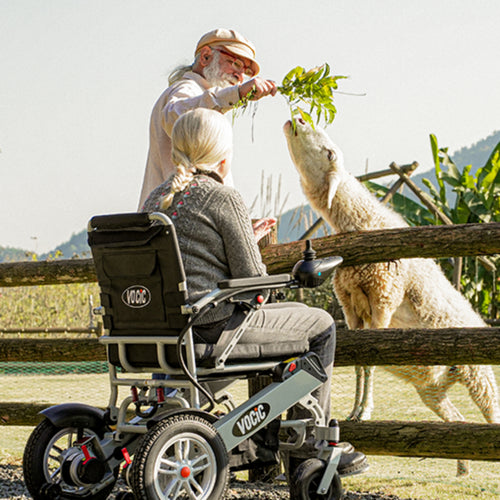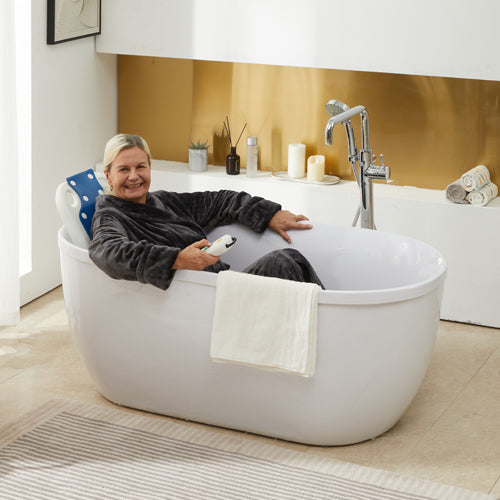Rollator walkers are designed to help people with limited mobility walk independently. With their sturdy frames and support handles, rollator mobility aids allow users to maintain their balance while walking, reducing the risk of falls and injuries. This article gives users tips on how to use a rollator safely and effectively.
Choosing the Right Rollator Walker
First, it is important to choose a good rollerwalker. Because it can provide sufficient stability and safety. I list some buying tips to help you as follows.
Factors to Consider When Selecting a Rollator Walker
-
Weight capacity and height adjustment: The weight capacity of a rolled walker should comfortably accommodate the user's weight for stability and safety. There are also adjustable height settings that are needed to customize the walker to the user's specific height and promote proper posture and use.
-
Size and type of wheels for different terrains: It is important to consider the type of terrain where the rollator will be used. Larger wheels are suitable for outdoor terrain and have better maneuverability on rough ground, while smaller wheels are suitable for indoor use where space is limited.
-
Weight Capacity: Choose a rollator that supports your weight plus a safety margin. Verify the maximum weight limit to ensure durability and stability.
-
Height Adjustability: When choosing a rollator walker based on weight capacity, prioritize a model that can handle your weight, plus an additional safety factor to ensure durability and stability. Specifically, choose a rollator that has a weight capacity of at least 20-30 pounds more than your current weight. This margin allows for additional items that may be carried and ensures that the rollator will remain stable in a variety of conditions.
-
Wheel Size: Larger wheels (8 inches or more) are better for outdoor use, navigating over rough terrain, and overcoming obstacles. Smaller wheels are suitable for indoor use, offering better maneuverability in tight spaces.
-
Terrain Suitability: Assess where the rollator will be primarily used. For varied terrains, consider models with larger, treaded wheels. For indoor use, smaller wheels and a narrower frame may be more appropriate.
-
Seat and Backrest: If the rollator will be used for extended periods, ensure it has a comfortable, durable seat and backrest for resting.
-
Storage: A built-in basket or pouch can be handy for carrying personal items securely.
-
Weight and Foldability: A lightweight, easily foldable rollator enhances portability and storage, especially for travel or when space is limited.

Setting the Correct Height
-
Start by standing up straight with your arms relaxed at your sides.
-
With your arms hanging down naturally, the handles of the Rollator should be aligned with the creases on the inside of your wrists.
-
Some rollators have adjustable legs that can be lengthened or shortened to achieve this alignment.
-
Once adjusted, the locking mechanism locks securely to prevent unintended changes during use.
Adjusting the Handle Grips
-
Comfortable Grip for Easy Control: The handle grip should allow the user to comfortably hold the Rollator and easily maneuver the Rollator while maintaining control during movement.
-
How to Adjust for Handles Size and Strength: Many rollators have adjustable handle heights and ergonomic grip designs to accommodate different handle sizes and strengths. Users should test different grip positions to find the most appropriate setting to maintain a natural, relaxed hand position while using the rollator walker.

Safe Practices for Beginning and Ending Movement
When using a rollator walker, you need to learn to use safe techniques for starting and ending the movement. These practices not only keep the user safe but also contribute to a smoother, more comfortable ride.
To begin walking with a rollator, users should first ensure that the brakes are released. Once ready, the rollator can be gently pushed forward while maintaining a stable position. It is recommended to start slowly and gradually build up the power. When stopping, the user should gently apply the brakes and get up again after coming to a complete stop.
When walking, be sure to drive slowly. You need to focus on maintaining a steady pace and avoid sudden stops or changes in direction. This will prevent you from falling.
Techniques for Indoor and Outdoor Terrains
When using a rollator indoors, it is recommended to maintain a slow speed and be aware of hazards such as loose carpeting or slippery areas. For outdoor access, it is recommended to prioritize stability, then choose the path with the least amount of obstacles and make sure the rollator is appropriate for the particular outdoor terrain.
Overcoming Common Barriers for Outdoor
Common obstacles such as thresholds, curbs, or narrow passages can present challenges when using a rollator. To safely navigate these obstacles, users can employ techniques such as approaching thresholds at an angle for a smoother transition or seeking alternative routes when encountering narrow passages.
Maintaining Your Rollator Walker
After using a roller walker, we need to maintain it so that we can improve its life and performance. Below we will go through a list of common maintenance:
Regular Cleaning and Inspection
In general, the frequency of cleaning depends on the frequency of use and environmental conditions; weekly cleaning is recommended if used frequently or outdoors. If used only indoors, monthly cleaning is recommended.
1. Maintenance Checklist-
Cleaning: Periodically wipe the frame, handle, and wheels with a damp cloth to remove dust, dirt, or any other debris.
-
Wheel Maintenance: Check the wheels for signs of wear or damage. Make sure the wheels turn smoothly and are free of any obstructions.
-
Brake Function: Test the brakes periodically to ensure they engage and disengage effectively. Adjust as necessary to maintain optimum braking performance.
-
Frame Inspection: Check the frame for cracks, loose screws, or other structural problems that may affect safety or stability.
-
Handle Grips: Check for broken or deteriorated grips, as worn grips can affect comfort and control during use.
Conclusion
Related Reading:How To Use A Wheelchair?







